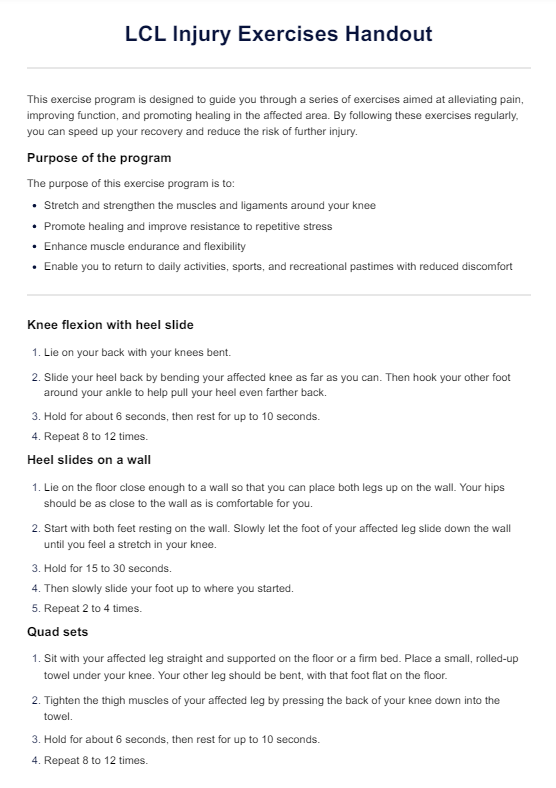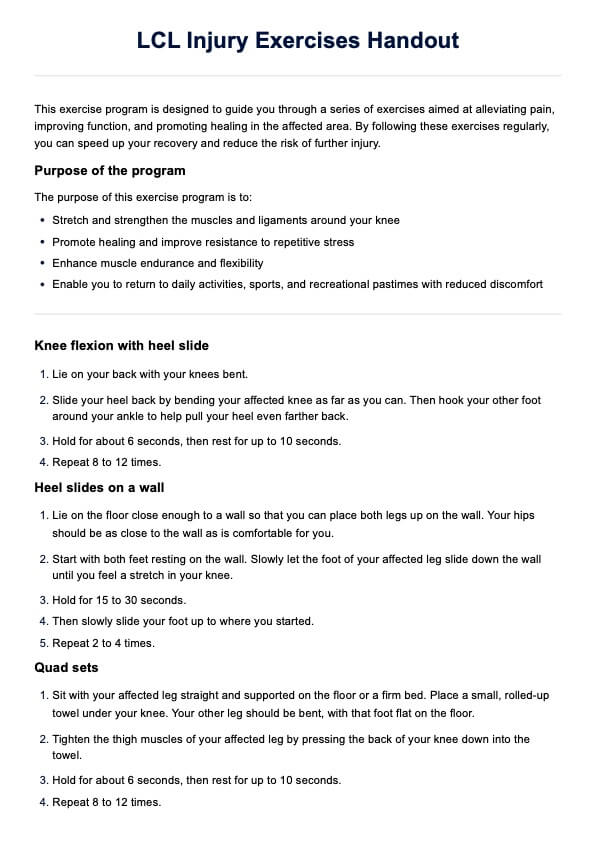LCL Injury Exercises Handout
Discover the benefits of our LCL Injury Exercises Handout for physical therapists. Download now and enhance patient care with Carepatron's comprehensive platform.


What is a lateral collateral ligament (LCL)?
The lateral collateral ligament (LCL) is one of the four major ligaments in the knee. It runs along the outer side of the knee, connecting the thigh bone (femur) to the smaller bone in the lower leg (fibula). The LCL helps stabilize the knee by preventing excessive side-to-side movement and ensuring the joint functions correctly during walking, running, and jumping.
Injuries to the LCL are typically caused by direct impact to the inside of the knee or by hyperextension, leading to pain, swelling, and instability in the knee joint.
LCL Injury Exercises Handout Template
LCL Injury Exercises Handout Example
How rehabilitation exercises can help with LCL injuries
Exercises play a crucial role in the rehabilitation of LCL injuries. Specific exercises can help strengthen the muscles surrounding the knee, improve flexibility, and enhance stability. By focusing on these areas, patients can reduce pain, increase their range of motion, and prevent further injury.
Strengthening exercises build the muscles that support the knee, reducing the stress on the LCL. Stretching exercises improve flexibility and help avoid stiffness, which can impede recovery. Meanwhile, rehabilitation exercises should begin once the initial acute period passes to ensure safe and effective recovery.
Consistently performing these exercises as part of a structured rehabilitation program can significantly speed up the healing process and help patients return to normal activities with reduced discomfort and improved knee function.
10 examples of LCL injury exercises
Healthcare professionals can use the following LCL sprain exercises to help patients rehabilitate from LCL injuries. Each exercise is designed to strengthen the muscles surrounding the knee, improve flexibility, and enhance overall stability.
1. Knee flexion with heel slide
Lie on the patient’s back with knees bent and feet flat on the floor. Instruct the patient to slide their heel back by bending the affected knee as far as possible, then hook the other foot around the ankle to pull the heel farther back. Hold for about 6 seconds, then rest for up to 10 seconds. Repeat 8 to 12 times.
2. Heel slides on a wall
Have the patient lie on the floor close enough to a wall to place both legs on it. Start with both feet resting on the wall, then slowly let the foot of the affected leg slide down the wall until a stretch is felt in the knee. Hold for 15 to 30 seconds, then slide the foot back up. Repeat 2 to 4 times.
3. Quad sets
Sit with the patient’s affected leg straight and supported on the floor or a firm bed, placing a small, rolled-up towel under the knee. Instruct the patient to tighten the quadriceps muscles of the affected leg by pressing the back of the knee down into the towel. Emphasize the contraction and relaxation of the quadriceps muscles. Hold for about 6 seconds, then rest for up to 10 seconds. Repeat 8 to 12 times.
4. Short-arc quad
Have the patient lie on their back with knees bent over a foam roll or a sizeable rolled-up towel. Instruct them to lift the lower part of the affected leg and straighten the knee by tightening the thigh muscle, keeping the bottom of the knee on the foam roll or towel. Hold for about 6 seconds, then slowly bend the knee and lower the leg. Repeat 8 to 12 times.
5. Straight-leg raises to the front
Have the patient lie on their back with the good knee bent so that the foot rests flat on the floor. Tighten the quadriceps muscles in the affected leg by pressing the back of the knee flat down, then lift the leg so that the heel is about 30 centimeters off the floor. Hold for about 6 seconds, then lower slowly, relaxing the quadriceps muscles. Repeat 8 to 12 times.
6. Hamstring set (heel dig)
Sit with the patient’s affected leg bent and the good leg straight and supported on the floor. Instruct the patient to tighten the hamstring muscles by pressing the heel into the floor. This will activate the inner and outer hamstring muscles. Hold for about 6 seconds, then rest for up to 10 seconds. Repeat 8 to 12 times.
7. Hip adduction
Sit on the floor with the patient's knees bent and place a pillow between them. Instruct the patient to squeeze the pillow by tightening the thigh muscles. Hold for 6 seconds, then rest for up to 10 seconds. Repeat 8 to 12 times.
8. Hip abduction
Sit on the floor with the patient's affected knee close to a wall. Bend the affected knee while keeping the other leg straight in front. Place a pillow between the outside of the knee and the wall, and instruct the patient to push the outside of the knee against the pillow and the wall. Hold for 6 seconds, then rest for up to 10 seconds. Repeat 8 to 12 times.
9. Lateral step-up
Stand the patient sideways on the bottom of a staircase with the injured leg on the step and the other foot on the floor. Instruct the patient to use the injured leg to raise themselves, bringing the other foot level with the stair step. Ensure they keep their hips level and the knee moving in a straight line with the middle toe, then slowly lower the foot back down. Repeat 8 to 12 times.
10. Wall squat with ball
Stand with the patient’s back facing a wall and place an exercise ball between the middle back and the wall. Instruct the patient to move their feet about a foot in front of their hips, tighten their belly muscles, and slowly squat down as if sitting in a chair, rolling the back over the ball. Ensure the knees do not go in front of the toes as they squat, hold for about 6 seconds, then slowly rise to a standing position. Repeat 8 to 12 times.
How our LCL Injury Exercises Handout works
Our LCL Injury Exercises Handout is designed to provide a comprehensive and structured approach to rehabilitating lateral collateral ligament injuries. This handout contains detailed instructions and illustrations for each exercise, ensuring patients can follow along accurately and effectively. Additionally, it includes a variety of rehabilitation exercises to aid in the recovery process.
Step 1: Download the handout
First, download the LCL Injury Exercises Handout from the Carepatron platform. You can also get it from our resources library.
Step 2: Review the handout with the patient
Sit down with the patient and review the entire handout together. Explain the purpose of each exercise and how it will help their recovery process. Ensure the patient understands the importance of performing these exercises regularly and correctly to maximize their benefits.
Step 3: Demonstrate each exercise
Demonstrate each exercise to the patient, highlighting the correct form and technique. This is crucial for preventing further injury and ensuring effective exercises. Ensure the patient feels comfortable and confident in performing each exercise independently.
Step 4: Provide clear instructions
Give the patient clear instructions on following the exercise program outlined in the handout. Emphasize the importance of adhering to each exercise's prescribed frequency, repetitions, and duration to achieve the best results. Answer any questions they may have to ensure they understand the program thoroughly.
Step 5: Schedule follow-up appointments
Schedule regular follow-up appointments to monitor the patient’s progress. During these visits, reassess their condition, make any necessary adjustments to their exercise program, and address any concerns or difficulties they may be experiencing. Consistent follow-up ensures ongoing support and optimal recovery.
Commonly asked questions
The lateral collateral ligament (LCL) is located on the outer side of the knee and connects the femur to the fibula. It is often injured by direct blows to the inside of the knee or from sudden changes in direction, which can overstretch or tear the ligament.
Exercises help by strengthening the muscles around the knee, improving flexibility, and enhancing stability. This reduces pain, increases range of motion, and prevents further injury.
LCL injury exercises should be performed as prescribed by a healthcare professional, typically several times a day, five to seven days a week, depending on the specific exercise and the patient's condition.






















-template.jpg)
















































































